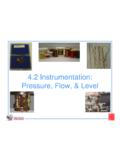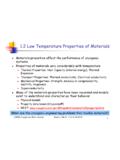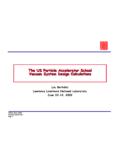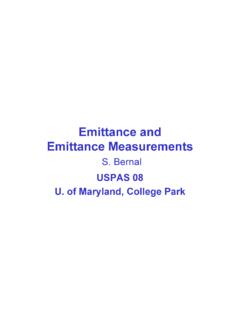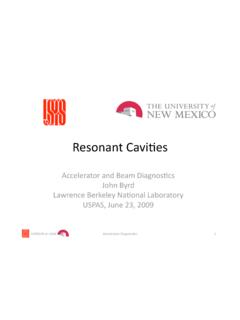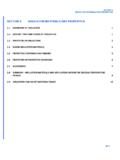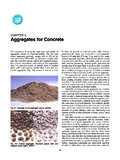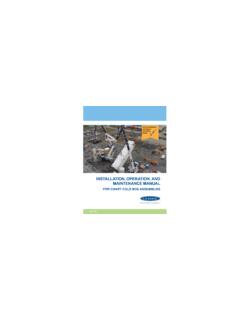Transcription of 5.1 Cryogenic system design - USPAS
1 USPAS Short course Boston, MA 6/14 to 6/18/2010 1 Cryogenic system design Low temperature environment Source of refrigeration Heat exchange medium Thermal insulation Structural support Instrumentation and control Refrig. I & C Structural support Thermal Insulation Heat Load Tlow Thigh USPAS Short course Boston, MA 6/14 to 6/18/2010 2 Thermal Insulation Systems Solid foam insulation Powder insulation Vacuum Radiation heat transfer Gas conduction/convection Multi-layer insulation Radiation shields (active and passive) MLI USPAS Short course Boston, MA 6/14 to 6/18/2010 3 Solid Foam Insulations Solid foam insulations are not used very often in cryogenics because they have relatively poor performance Since these materials are typically gas filled, their thermal conductivity is > kair ~ 25 mW/m K.
2 Example: Consider a Polystyrene LN2 vessel with 20 mm wall and 1 m2 surface area. Heat leak: Q = kA T/L = 33 mW/m K x 1 m2 x (300 77) K / m = 368 W hfg (LN2) = 200 J/g; ~ 800 g/L dm/dt = g/s ( L/hr) USPAS Short course Boston, MA 6/14 to 6/18/2010 4 Vacuum Insulation High performance insulation systems all involve some level of vacuum. How low vacuum is needed? Even for perfect vacuum, thermal radiation can still contribute significantly to total heat leak QR ~ T4 so process is dominated by high temperature surfaces (usually 300 K) Liquid Cryogen Vacuum T = 300 K Vent QR USPAS Short course Boston, MA 6/14 to 6/18/2010 5 Thermal Radiation Radiation from room temperature is one of the main heat loads in Cryogenic systems Black body spectrum is ideal emitted power versus wavelength of radiation Integral of spectrum is total emitted power where = x 10-8 W/m2K4, the Stefan-Boltzman constant USPAS Short course Boston, MA 6/14 to 6/18/2010 6 Radiant Emissivity ( )
3 Emissivity is the property of a surface material that determines the fraction of radiant flux that is absorbed or emitted. depends on material conductivity, temperature is also a function of wavelength, but engineering usually relies on average values measured for range of temperatures For a real surface, USPAS Short course Boston, MA 6/14 to 6/18/2010 7 Radiation heat transfer Net heat transfer for two facing black body surfaces For non-black bodies, the heat exchange between surfaces depends on the emissivity of each surface: Example.
4 Radiant heat transfer between 300 K and 77 K ~ , q = x x 10-8 x (3004 774) = W/m2 hfg (LN2) = 200 kJ/kg and the density, = 800 kg/m3 volume consumption = W/m2/200 J/g = g/sm2 or about liter/hour of LN2 (much better than foam) Note if the low T surface were at 4 K in Helium, the liquid consumption would be larger because hfg(LHe) is about 21 J/g Photon radiation exchange For 1 ~ 2 = and << 1, ( ) ~ /2 Vacuum =T1 T2= Two surfaces facing each other with vacuum between USPAS Short course Boston, MA 6/14 to 6/18/2010 8 Heat exchange with imperfect vacuum Residual heat leak due to gas conduction can contribute significantly to heat loading to a Cryogenic system At pressures near 1 Atm, the heat transfer is by natural convection At lower pressure, convection is reduced, but gas conduction still can transfer considerable heat, k (T).
5 This regime occurs for gas densities where the mean free path is less than the wall spacing. In addition to radiation heat transfer, gas conduction due to poor vacuum can seriously affect thermal performance =T1 T2= gas USPAS Short course Boston, MA 6/14 to 6/18/2010 9 Gas conduction heat transfer At pressures below about 1 Pa, the mean free path of the molecule begins to exceed the distance between surfaces and heat is carried by Molecular-Kinetic processes For helium gas at 1 Atm (100 kPa) and 300 K, l ~ 60 nm For helium at 1 Pa and 300 K, l ~ 6 mm, a distance comparable to spacing in containers In the molecular kinetic regime, the heat exchange depends on Number of molecules striking the surface/unit time The thermal equalization of the molecule with the surface Probability that the molecule sticks to the surface Where d is the molecule diameter and p is the pressure USPAS Short course Boston, MA 6/14 to 6/18/2010 10 Adsorption & Accommodation Coef.
6 Molecules are attracted to solid surfaces by Van der Waal s forces just as with intermolecular interactions is the accommodation coefficient that measures the amount that a molecule comes in thermal equilibrium with the wall. For heat exchange between two surfaces, it is necessary to use an average accommodation coefficient, U r r Ti is the temperature of the incident molecule Te is the temperature of the emitted molecule Tw is the temperature of the wall Note: If the surfaces are not of equal area, geometric corrections are required for this formula USPAS Short course Boston, MA 6/14 to 6/18/2010 11 Gas conduction heat exchange In the molecular kinetic regime, heat transfer between two parallel surfaces can be calculated using the expression, Values for accommodation coefficients.
7 Decreases with cleaner surfaces increases with decreasing temperature to ~1 at T ~ TNBP For rough calculations, ~ is practical Where = Cp/Cv Surface condition Transport gas Temperature (K) Accommodation coefficient Very clean helium 300 < Engineering helium 300 Engineering helium 20 Engineering nitrogen 250 USPAS Short course Boston, MA 6/14 to 6/18/2010 12 Example of gas conduction heat transfer Consider a 100 liter (A = 1 m2) cryostat for storing liquid nitrogen. Calculate the consumption of LN2 if the vessel is only vacuum insulated.
8 (hfg = 198 kJ/kg). Radiant heat transfer between 300 K and 77 K (assume ~ ) q = x x 10-8 x (3004 774) = W ( g/s) Calculate the consumption if the vessel had a poor vacuum with helium at p ~ Pa (10-6 Atm) LN2 Adds to the radiation heat transfer doubling the heat load Conclusion: Good vacuum is highly desirable USPAS Short course Boston, MA 6/14 to 6/18/2010 14 Multi layer shielding Adding shielding between the radiant surfaces can significantly reduce the heat transfer. For n shields with emissivity e, the heat exchange is which for << 1, reduces the qr by a factor of 1/n+1 Note that the shield temperatures are not equally distributed because the heat exchange is not linear.
9 Consider one shield and all emissivities = in steady state; or Vacuum =T1 T2= =T1 T2= Ts ~ 252 K for T1 = 300 K and T2 = 77 K USPAS Short course Boston, MA 6/14 to 6/18/2010 15 Refrigerated radiation shields There is significant thermodynamic advantage to actively cooling radiation shields in a Cryogenic system . Examples: LN2 shield cooling in a cryostat Vapor cooling in LHe storage vessels Refrigerated shields Why would you want to do this? Thermodynamic advantage of removing heat at higher temperature (COP) Reduce boil-off of expensive fluid (LHe) Can be done in conjunction with active cooling of other components (structural supports, current leads) USPAS Short course Boston, MA 6/14 to 6/18/2010 16 Multilayer Insulation (MLI) MLI is a material developed to approximate thermally insulated shields.
10 MLI consists of aluminum (5 to 10 nm thick) on Mylar film usually with low density fibrous material between layers Insulation must operate in vacuum Heat transfer is by a combination of conduction and radiation MLI must be carefully installed covering all surfaces with parallel layers, not wrapped since conduction along layer will produce a thermal short Engineering applications must include factor of safety compared to ideal data Radiation heat load for different densities between K and 77 K Conduction contribution Radiation contribution Recommended conservative values.
